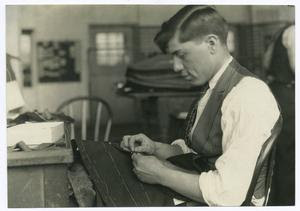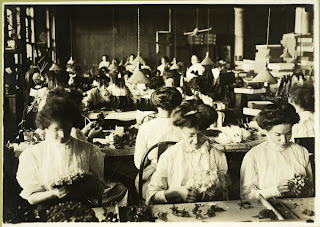

Sunday, March 27th, 2011
 This morning 123 women and 23 men will be walking the workers who died in The Triangle Waist Factory Fire home. 146 people, mothers, daughters, workers from all walks of life will gather at 146pm in front of Asch Building on the corner of Washington Place and Greene Street. Dressed in costume, bedecked in veils and wearing a placard with the name of their worker, there will be a short performance of music at the site of the fire featuring Deborah Strauss, Jeff Warschauer, children from the Midtown Workman's Circle Shule and the New Yiddish Chorale.
This morning 123 women and 23 men will be walking the workers who died in The Triangle Waist Factory Fire home. 146 people, mothers, daughters, workers from all walks of life will gather at 146pm in front of Asch Building on the corner of Washington Place and Greene Street. Dressed in costume, bedecked in veils and wearing a placard with the name of their worker, there will be a short performance of music at the site of the fire featuring Deborah Strauss, Jeff Warschauer, children from the Midtown Workman's Circle Shule and the New Yiddish Chorale. 

 Many of the young women and men who died in the Triangle Fire, were engaged to be married. One woman had just had her engagement party the night before the fire, before she died. Another worker burned beyond recognition was identified by her fiance by the engagement ring still on her finger.
Many of the young women and men who died in the Triangle Fire, were engaged to be married. One woman had just had her engagement party the night before the fire, before she died. Another worker burned beyond recognition was identified by her fiance by the engagement ring still on her finger. Then came the love amid the flames. He brought another girl to thewindow. Those of us who were looking saw her put her arms about him and kiss him. Then he held her out into space and dropped her. But quick as a flash he was on the window sill himself. His coat fluttered upward-the air filled his trouser legs. I could see that he wore tan shoes and hose. His hat remained on his head.

Thud-dead, thud-dead-together they went into eternity. I saw his face before they covered it. You could see in it that he was a real man. He had done his best.
We found out later that, in the room in which he stood, many girls were being burned to death by the flames and were screaming in an inferno of flame and heat. He chose the easiest way and was brave enough to even help the girl he loved to a quicker death, after she had given him a goodbye kiss. He leaped with an energy as if to arrive first in that mysterious land of eternity, but her thud-dead came first."
After we walk our 146 sweatshop workers home on Sunday, March 27th, we will all congregate at the Eldridge Street Synagogue for an afternoon of music and poetry written by the Yiddish sweatshop poets about the relentless soul crushing grind of life in the factory. One of Morris Rosenfeld's poems, To My Beloved, tells the tale of a factory worker with no time to spend in the arms of his beloved as they are both at work all day long.
He writes:
It hums, it boils, it burns, it seethes
There is no place for you – o go-
I hired out my arms and hands;
I cannot now embrace you – no!
And though without you I am dead
I must demand of you - please go
Here rules the struggle harsh for bread
And I must tremble when I sew.

This poem will be performed in its entirety by Melanie Martinez at left and Yankl Salant in English and Yiddish on March 27th at 3pm at The Eldridge Street Synagogue.
 The talented photographer Louie Correia will be taking individual portraits of each of our 146 walkers. Here are some portraits of sweatshop workers for inspiration.
The talented photographer Louie Correia will be taking individual portraits of each of our 146 walkers. Here are some portraits of sweatshop workers for inspiration. 



